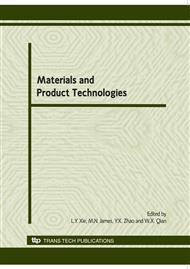p.186
p.191
p.196
p.201
p.206
p.211
p.216
p.221
p.226
Investigation of the Hydrogen Embrittlement on the 65Mn Steel from the Nuclear Power Plant with Small Punch Method
Abstract:
Damage of metals due to the influence of hydrogen is quite frequent and leads to dangerous failures. The characteristics of the hydrogen embrittlemnt of the 65Mn steel were evaluated with small punch test. With the increment of the amount of the hydrogen absorbed into the alloy at room temperature, the strength and the toughness of the material reduce. From the small punch experimental results, it is found the total impact energy, the fracture strain and the fracture stress decrease with the increment of the cathodic hydrogen charging time. The fracture surfaces change from the typical ductile fracture with big voids to the typical intergranular brittle fracture mode after hydrogen absorbed in the specimens with higher charging current density.
Info:
Periodical:
Pages:
206-210
Citation:
Online since:
June 2010
Authors:
Keywords:
Price:
Сopyright:
© 2010 Trans Tech Publications Ltd. All Rights Reserved
Share:
Citation:


